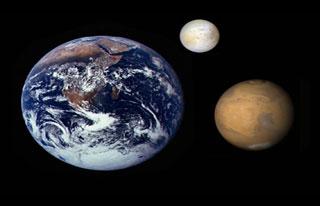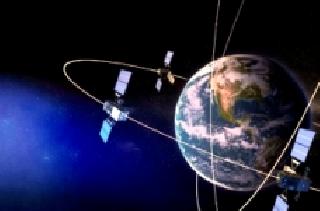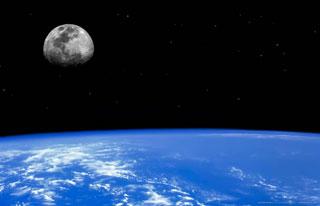
Earth, Mars, Europa to scale. Photo: NASA/JPL/Malin Space Science Systems.
LONDON (PTI): Bringing Mars rocks to Earth and a mission to Jupiter's icy moon, Europa, should be among the top priorities for NASA in the coming decade, a high-level panel of planetary scientists has suggested.
The National Research Council, which released a to-do list for NASA for the decade 2013-2022, also said if the US space agency cannot afford such multi-billion-dollar "flagship missions", they should be delayed in favour of smaller ones, the New Scientist reported.
In its decadal survey of planetary science missions, the council recommended that NASA should make a Mars sample return mission its top priority among its large planetary science missions.
Bringing Martian rocks back to Earth, it said, would allow scientists to study them with a much wider array of instruments than can be packaged on a Martian rover. That in turn would allow scientists to better search for signs of past or present life, the report noted.
"If we are to advance our fundamental knowledge of whether life has existed elsewhere in the solar system, we have to bring samples back," said Jack Mustard of Brown University in Providence, Rhode Island, who was not a member of the panel.
"We could go on for another 50 years sending rovers, but I think the next ultimate step in our understanding will come from sample return."
Because of budget limitations, the panel recommended moving forward only with the first stage of such a sample return mission in the coming decade -- a rover called Mars Astrobiology Explorer-Cacher (MAX-C) that would find and collect the samples.
A second mission could later be sent to launch these samples into Mars orbit, while a third mission would bring them back to Earth.
MAX-C is estimated to cost USD 3.5 billion but the panel hopes NASA can tweak its design to shave USD 1 billion off that price tag.
The panel's second-highest priority for large missions is a probe that would orbit Europa, thought to harbour an ocean of liquid water beneath its surface.
The mission, the panel said, would help assess the moon's potential for hosting life by trying to confirm the presence of an ocean and determining how far the ocean lies below the moon's icy surface.
The mission, estimated to cost USD 4.7 billion, would also study the surface to help identify interesting landing sites for future missions, the panel said.
NASA has already been studying the concept as part of a possible joint mission with the European Space Agency, which would supply an orbiter for Ganymede, another icy moon of Jupiter with a possible ocean beneath its surface.
Other large missions that the panel recommended, though at a lower priority than the Mars sample return and Europa missions, included an orbiter and atmospheric probe for Uranus, an orbiter for Saturn's icy moon, Enceladus and an orbiter to study Venus's climate.
The panel, whose recommendations are not binding on NASA, also encouraged moving forward with a small mission called the Mars Trace Gas Orbiter, which would try to determine the source of methane observed on Mars, which some scientists say could be due to life.
 Previous Article
Previous Article Next Article
Next Article













The Indian Air Force, in its flight trials evaluation report submitted before the Defence Ministry l..
view articleAn insight into the Medium Multi-Role Combat Aircraft competition...
view articleSky enthusiasts can now spot the International Space Station (ISS) commanded by Indian-American astr..
view article